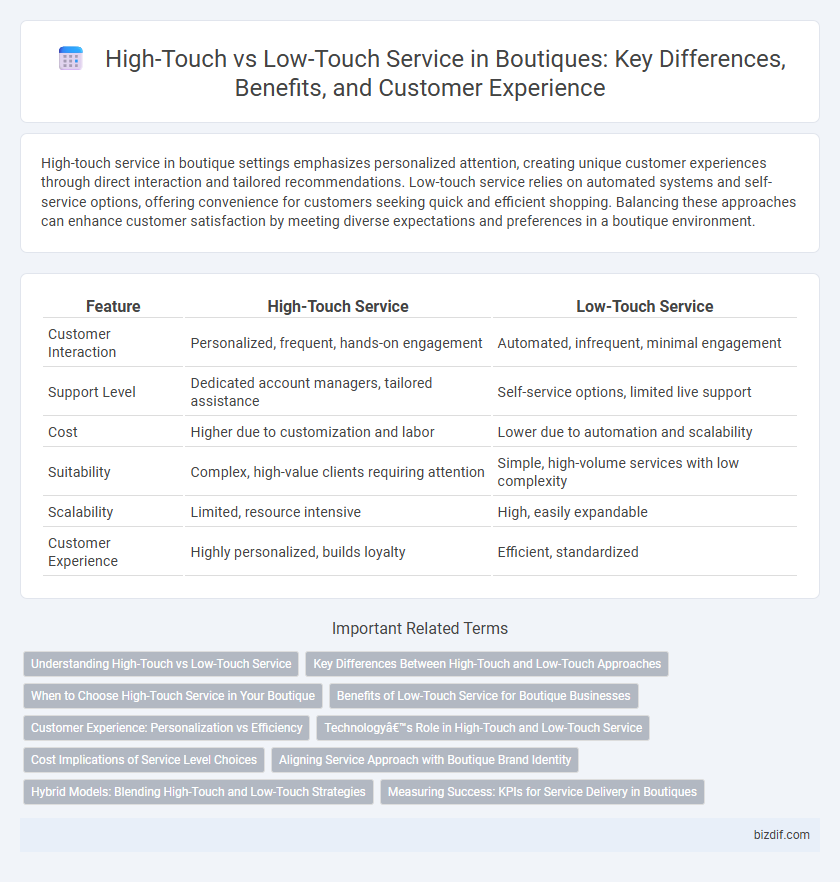High-touch service in boutique settings emphasizes personalized attention, creating unique customer experiences through direct interaction and tailored recommendations. Low-touch service relies on automated systems and self-service options, offering convenience for customers seeking quick and efficient shopping. Balancing these approaches can enhance customer satisfaction by meeting diverse expectations and preferences in a boutique environment.
Table of Comparison
| Feature | High-Touch Service | Low-Touch Service |
|---|---|---|
| Customer Interaction | Personalized, frequent, hands-on engagement | Automated, infrequent, minimal engagement |
| Support Level | Dedicated account managers, tailored assistance | Self-service options, limited live support |
| Cost | Higher due to customization and labor | Lower due to automation and scalability |
| Suitability | Complex, high-value clients requiring attention | Simple, high-volume services with low complexity |
| Scalability | Limited, resource intensive | High, easily expandable |
| Customer Experience | Highly personalized, builds loyalty | Efficient, standardized |
Understanding High-Touch vs Low-Touch Service
High-touch service in boutiques emphasizes personalized, face-to-face interactions with clients, creating a tailored shopping experience through attentive staff and detailed product knowledge. Low-touch service relies on digital interfaces and self-service options, offering convenience and efficiency but less direct human engagement. Understanding the balance between high-touch and low-touch service helps boutiques customize their approach to meet diverse customer preferences and enhance overall satisfaction.
Key Differences Between High-Touch and Low-Touch Approaches
High-touch service emphasizes personal interactions, tailored experiences, and direct customer engagement often found in luxury boutiques, enhancing customer loyalty and satisfaction through individualized attention. Low-touch service relies on automation, digital tools, and self-service options to efficiently handle high volumes with minimal human involvement, commonly used in large-scale retail operations. Understanding this key difference enables boutique owners to strategically choose the approach that aligns best with their brand identity and customer expectations.
When to Choose High-Touch Service in Your Boutique
High-touch service in boutiques is essential when catering to clients seeking personalized attention, luxury products, or complex purchases requiring expert guidance. This approach enhances customer loyalty and satisfaction through tailored recommendations, in-depth product knowledge, and dedicated support. Boutiques should prioritize high-touch service during peak shopping seasons, exclusive events, or when launching new collections to create memorable, high-value experiences.
Benefits of Low-Touch Service for Boutique Businesses
Low-touch service in boutique businesses enhances efficiency by streamlining customer interactions through digital tools, reducing wait times and operational costs. This approach allows boutiques to scale personalized experiences without requiring extensive staff involvement, improving customer satisfaction and loyalty. Automated systems also facilitate consistent service quality, enabling boutiques to maintain strong brand reputation while adapting to evolving consumer preferences.
Customer Experience: Personalization vs Efficiency
High-touch service in boutiques emphasizes personalized customer experience by offering tailored recommendations, attentive assistance, and creating memorable shopping interactions that foster loyalty. Low-touch service prioritizes efficiency through streamlined processes, self-service options, and reduced wait times, appealing to customers who value speed and convenience. Balancing personalization with operational efficiency enhances overall satisfaction and meets diverse customer preferences in boutique retail environments.
Technology’s Role in High-Touch and Low-Touch Service
High-touch service leverages advanced technologies like AI-driven personalized recommendations and real-time customer support to create deeply engaging, tailored experiences. Low-touch service relies on streamlined automation tools such as chatbots and self-service portals to efficiently manage high volumes while maintaining customer satisfaction. Integrating cutting-edge CRM systems enhances both approaches by optimizing customer data usage and improving response accuracy.
Cost Implications of Service Level Choices
High-touch service involves personalized interactions that increase labor costs and require more staff training, resulting in higher operational expenses for boutiques. Low-touch service minimizes direct contact through automation or self-service options, reducing costs but potentially impacting customer satisfaction. Balancing these service levels effectively can optimize budget allocation while maintaining brand exclusivity and client loyalty in the boutique sector.
Aligning Service Approach with Boutique Brand Identity
Aligning service approach with boutique brand identity requires balancing high-touch and low-touch service models to reflect the brand's unique values and customer expectations. High-touch service emphasizes personalized interactions, luxury experiences, and attention to detail, reinforcing exclusivity and customer loyalty. Low-touch service leverages efficiency and convenience, suitable for boutiques targeting tech-savvy clients who prioritize speed without compromising brand authenticity.
Hybrid Models: Blending High-Touch and Low-Touch Strategies
Hybrid boutique service models combine high-touch personalization with low-touch efficiency, creating a seamless customer experience that leverages digital tools without sacrificing human connection. This approach enables boutiques to customize interactions based on client preferences, using data-driven insights to deliver tailored recommendations while automating routine tasks. Blending high-touch and low-touch strategies enhances customer satisfaction, boosts loyalty, and optimizes operational costs.
Measuring Success: KPIs for Service Delivery in Boutiques
Measuring success in boutique service delivery hinges on KPI metrics such as customer satisfaction scores, repeat purchase rates, and personalized engagement levels. High-touch service boutiques track in-depth client interactions and tailored recommendations, driving loyalty and premium sales growth. Low-touch service models emphasize efficiency through faster service times and automated feedback collection, balancing cost-effectiveness with basic customer retention.
High-Touch Service vs Low-Touch Service Infographic

 bizdif.com
bizdif.com